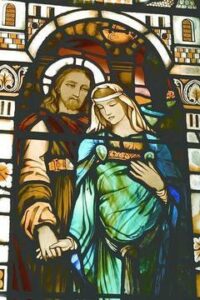
Joan Norton wrote about Sacred Marriage this week on our discussion forum:
Sacred marriage is a mechanism of enlightenment, in my view. It is the psychological principle by which growth of the mind and heart happens on our path with God… through intimacy between people and through an intimate relationship with one’s own psyche/soul/heart/mind. The soul speaks through dreams and the story metaphors used are based on nature’s processes of intimacy, birth, growth and death. In my experience, people grow towards God-realization through intimate encounter with other people or through their own inner life. That intimacy is what is sacred about partnership, sacred marriage. I don’t know how there could be an effective religion without a story of intimacy. There has to be a model for loving intricacy of care other than the mother-child model. I love all images of the archetypal mother but they are not psychologically the same as images of two people –or gods–in love and creating life together. If loving intimacy is seen only in the Madonna/child story it becomes incestuous. It sets up a longing for a kind of immersion in an unquestioning love that doesn’t always encourage growth. Mary Magdalene requests things of Jesus and she cries adult-woman tears that change his course of action.
   Everything I know about the historical likelihood of  sacred marriage being the very heart of our Christian story I have learned from Margaret Starbird’s books and some others; but the real strength of my convictions about it came from inside myself. I’ve met a number of woman who’ve told me that when they were little girls looking at the stained glass window stories of Christianity they just knew that Mary Magdalene was Jesus’ girlfriend. It’s like that.
In Their Name,
Joan
Margaret Starbird writes:
Thanks for your wonderful remarks about the importance of the Sacred Marriage in the psyche, Joan. Â Carl Jung says that the “Self” is often “imaged as a Divine or Royal couple” … : Â )
Although the canonical Gospels do not agree as to the date, all four evangelists tell the story of the anointing of Jesus by the woman with the alabaster jar, confirming that this event was one of great importance to the earliest Christians. Â Why? There are only a handful of stories that occur in all four Gospels, and this is one of them. Â The others are:
1) the Baptism of Jesus by his cousin John
2) mulitplication of loaves and fishes
3) overturning the money changers’ tables in the Temple
4) the Crucifixion.
That should give us some idea as to the importance of the “Anointing at Bethany.”
In researching the background for the anointing of the Messiah by a woman, I discovered that this anointing of Christ in the Gospels is reminiscent of an ancient marriage rite  of “Hieros gamos” in indigenous to fertility cults in the Middle East.  The royal bride chose her consort from among the available bachelors and anointed him ceremonially as a prefiguring of the “anointing” during the marriage act in the bridal chamber.  After the consummation of the marriage, the couple was feted with a nuptial banquet–sometimes lasting for days–and the joy from the “bridal chamber” spread out into their domain, blessing the crops and herds.
Later in the liturgical season, the Bridegroom King was arrested–tortured, mutilated and executed–and laid in a tomb. Â On the third day, the Bride went to the tomb to mourn the death of her Bridegroom and was overjoyed to find him resurrected in the Garden! Â The ancient cults of “hieros gamos” celebrate the eternal return of Life at the time of the spring equinox… Â Even the name of our East er celebration hints of these ancient roots in the “sacred marriage” festival honoring Astarte (later “Oestare”), Â “Bride of the Easter Mysteries” in Canaan.
This week, “a few days before the Passover,” we read the Gospel story of the anointing of Jesus by Mary, the sister of Lazarus (John 11:2 and 12:3-5). Â When Judas complained about the wasted perfume, valued at a man’s year’s wage, Jesus said, “Let her keep it for the day of my burial.” Â The Mary who is present in all four Gospels and both cross and tomb is Mary Magdalene, the Bride who embraces her Beloved in the Garden on Easter morning, re-enacting the ancient mythology of the “Sacred Marriage.” Â I believe that Mary Magdalene and Jesus embody the “hieros gamos” of the archetypal “Holy Bride” and “Sacred Bridegroom” with which the peoples of the ancient Near East were well familiar.
The “fragrance of the Bride”–her “precious nard”–is mentioned in the Gospel narratives. Â The only other place in the Hebrew Scriptures where “nard” is mentioned is in the “Song of Songs” (aka “Song of Solomon”) where the fragrance of the Bride wafts around the Bridegroom as he reclines at the banquet table. In John’s Gospel, her fragrance “fills the house.”
Here are lines from the Song of Songs, a poem known to have derived from an ancient liturgy celebrating the “sacred marriage” of Osiris and Isis:
Let him kiss me with the kisses of his mouth!
For your love is better than wine.
Your oils have a pleasing fragrance;
your name spoken is a spreading perfume.
…
While the king was at his table
the fragrance of my nard wafted around him.
…
How much more delightful is your love than wine
And the fragrance of your oils than all spices!
*********
The Gospel of Philip (from the Nag Hammadi Gnostic library) mentions Jesus’ frequent kisses — which apparently made the Apostles jealous of Mary Magdalene. In that 2-3rd c. text, Mary is called the “koinonos” (“companion” or “consort”) of the Lord—
Â
In memory of Her–
Margaret
“The Woman with the Alabaster Jar”
*************
For more on the esoteric meaning of Easter visit our Easter Cycle observances page